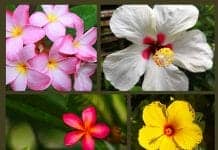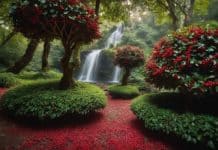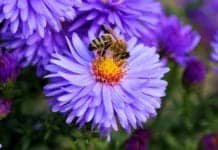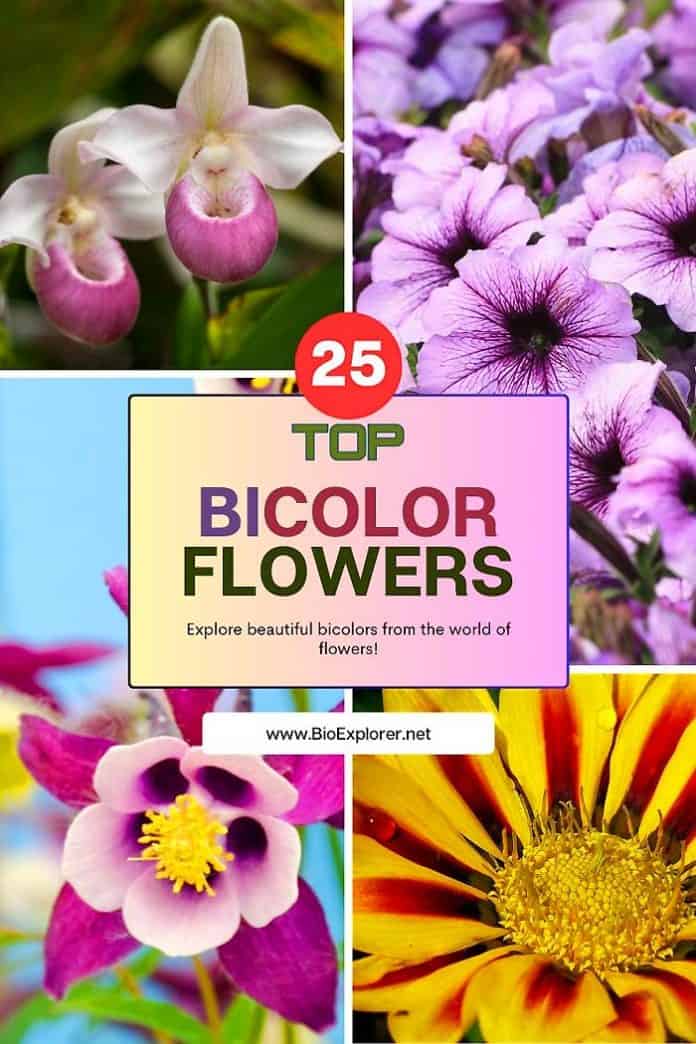
Have you ever seen a flower that looks like it’s wearing two different colors? That’s what we call a bicolor flower. These flowers are super cool because they have two colors instead of just one.
Bicolor flowers are like nature’s own magic trick. One part of the flower might be red, and another part might be yellow. It’s like they can’t decide what color to be!
Why do we love these two-colored flowers so much? Well, they’re just so fun to look at! It’s like finding a surprise in your garden. Plus, they make great decorations because they’re so pretty and unusual.
Table of Contents
- Top 25 Bicolor Flowers
- 1. Sweet Pea: Nature’s Perfumed Candy
- 2. Columbine: Dancing Fairy Skirts in the Garden
- 3. African Daisy: Sun-Loving Stunners
- 4. Painted Daisy: Nature’s Own Fireworks Display
- 5. Gazania: The Treasure Flowers of the Plant World
- 6. Butterfly Weed: Monarch’s Favorite Pit Stop
- 7. Beach Morning Glory: Sand Dune Decorator
- 8. Coneflower: Purple-Crowned Prairie Royalty
- 9. Indian Paintbrush: Nature’s Own Paintbrush
- 10. Trillium: Three-Petaled Forest Gems
- 11. Lewisia: Rock Garden Jewels
- 12. Lenten Rose: Winter’s End Heralded in Two-Tone
- 13. Clarkia: Farewell-to-Spring in Technicolor
- 14. Bird of Paradise: Tropical Splendor in Flower Form
- 15. Passion Flower: Nature’s Clock in Bloom
- 16. Showy Lady’s Slipper: Orchid Royalty of the North
- 17. Lotus: Sacred Beauty Rising from the Mud
- 18. Fringed Gentian: Blue Beauties of the Late Summer
- 19. Jack-in-the-Pulpit: The Preacher of the Woods
- 20. Turk’s Cap Lily: Nodding Elegance in the Wild
- 21. Coral Root Orchid: The Ghostly Forest Dweller
- 22. Blue-eyed Mary: Seaside Stunner
- 23. Shooting Star: Cosmic Beauty in Miniature
- 24. Toad Lily: Spots and Speckles in the Shade
- 25. Prairie Fire: Nature’s Own Paintbrush
- Growing Your Own Bicolor Garden
- Frequently Asked Questions
- Final Thoughts
Top 25 Bicolor Flowers
1. Sweet Pea: Nature’s Perfumed Candy
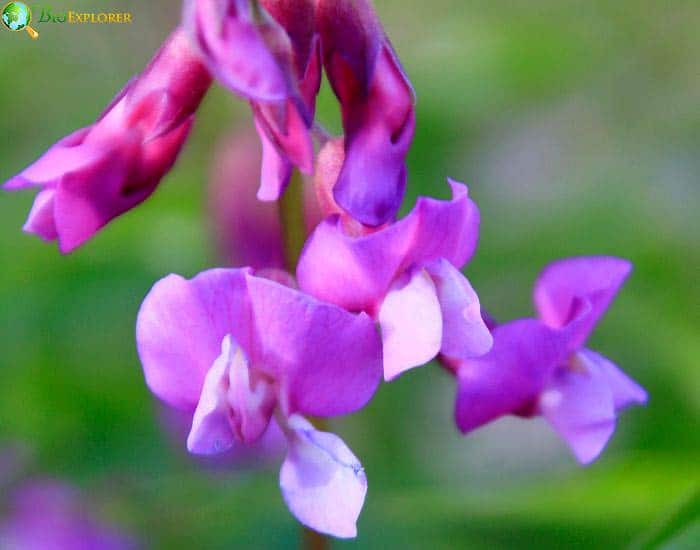
| Plantae | Fabales | Fabaceae | Lathyrus | Lathyrus odoratus |
Sweet peas are the superstars of the bicolor flower world. These climbers show off two colors on each bloom, making them twice as nice. Imagine a flower that looks pretty and smells like candy – that’s a sweet pea for you!
Common Names: Sweet peas are also known as “annual pea”, “garden pea flower” or simply “Lathyrus”. Some folks call them “climbing vines” because of how they grow.
Natural Habitat: Sweet peas originally come from Sicily, southern Italy and the Aegean islands. They like to grow in grassy places or along the edges of woods in the wild. They’re climbers, so they often wrap around other plants or rocks to reach for the sun.
Colors: Sweet peas come in lots of color combos. You might see pink and white, purple and blue, or even red and yellow. It’s like they can’t make up their mind which color to be!
Smell: Close your eyes and take a whiff – sweet peas smell so good, you might think you’re in a candy store. No wonder people use their scent in perfumes!
Growing Tips:
- Plant them early in spring they like it cool.
- Give them something to climb on, like a fence or trellis.
- Pick the flowers often to get more blooms.
- Sweet peas prefer full sun and well-drained soil.
- At maturity, this flower plant grows up to 6 to 8 feet.
 Even though they’re called “sweet peas”, you can’t eat them. They’re just for looking at and smelling!
Even though they’re called “sweet peas”, you can’t eat them. They’re just for looking at and smelling!2. Columbine: Dancing Fairy Skirts in the Garden
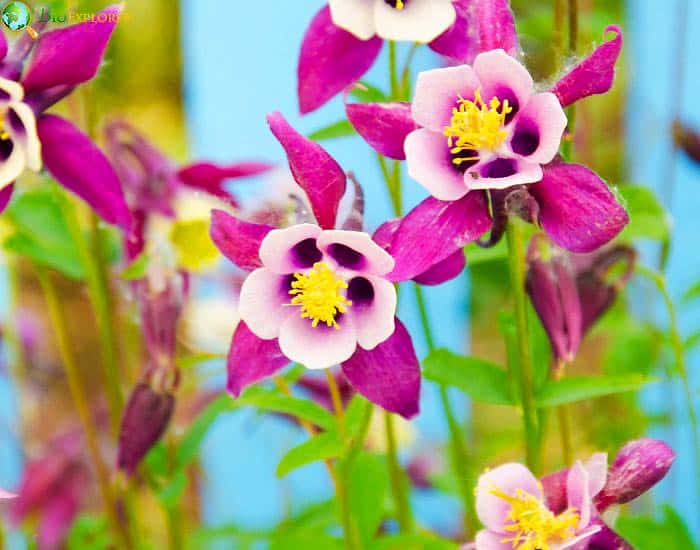
| Plantae | Ranunculales | Ranunculaceae | Aquilegia | Aquilegia caerulea |
Columbines are like the ballerinas of the flower world. Their two-toned blooms resemble tiny dancers with frilly skirts bobbing and swaying in the breeze. These pretty flowers add a touch of magic to any garden.
Common Names: Rocky Mountain Columbine, Colorado Blue Columbine, Colorado Columbine
Natural Habitat: Aquilegia caerulea, also known as Colorado blue columbine, is native to the Rocky Mountains. You’ll find them in the wild in mountain meadows, open woods, and rocky slopes. They’re tough little plants that can handle cold mountain air and rocky soil[1].
Colors: Columbines show off some cool color combos. You might see blue-white, violet-blue, purple-white, or blue-yellow. It’s like each flower is wearing a fancy costume!
Shape: The flowers have a special shape with spurs at the back. Some people think they look like little birds or jester’s caps.
Growing Tips:
- Plant them where they’ll get some sun and some shade.
- They like soil that drains well not too wet!
- Once they’re happy, they’ll come back year after year.

- Hummingbirds love columbines! The flower’s long spurs are perfect for the birds’ long beaks.
- Colarado blue columbine is the state flower of Colarado.
- Blue columbine plant reaches up to 2 feet.
- Blooms in late spring to early summer.
3. African Daisy: Sun-Loving Stunners
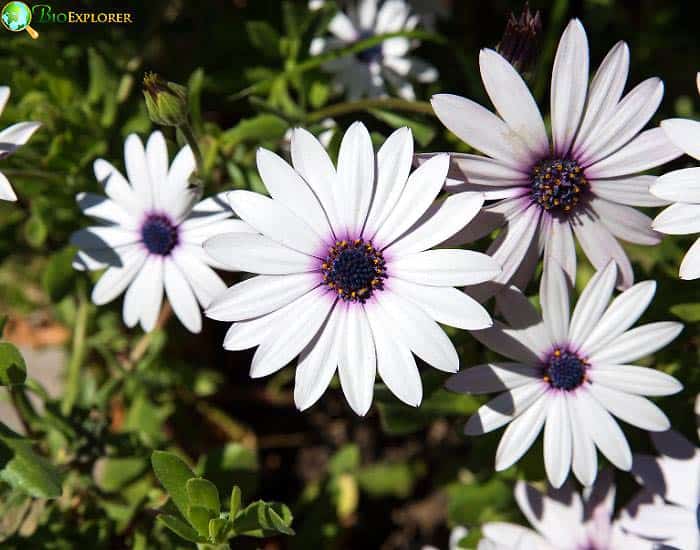
| Plantae | Asterales | Asteraceae | Osteospermum | Osteospermum ecklonis |
African daisies are like little suns you can plant in your garden. These bright, cheerful flowers love soaking up the sunshine and showing off their two-tone petals.
Common Names: African daisies have a few other names, too. Some people call them “Cape daisies” because they come from the Cape region of South Africa. You might also hear them called “blue-eyed daisies” or “sunscape daisies. “
Natural Habitat: These flowers come from South Africa growing in dry, sunny areas. You’ll find them in the wild in rocky places or sandy soils. They’re tough plants that can handle hot, dry weather – just like their home in Africa!
Colors: African daisies come in lots of eye-catching color combos. You might see purple-white, orange-yellow, or even pink-blue. The middle of the flower is usually a different color from the petals, making them true bicolor beauties.
Sun Seekers: These flowers are real sun worshippers. They open up when the sun’s out and close at night or on cloudy days. It’s like they’re playing peek-a-boo with the sun!
Growing Tips:
- Plant them in a spot that gets lots of sun.
- Don’t water them too much they like it on the dry side.
- They’re great for hot, sunny areas where other flowers might struggle.
- These African beauties grow as annuals in most regions but perennials in USDA zones 10-11.

- There are over 50 species of Osteospermum.
- Some types of African daisies change color as they get older. It’s like they’re playing dress-up in your garden!
4. Painted Daisy: Nature’s Own Fireworks Display
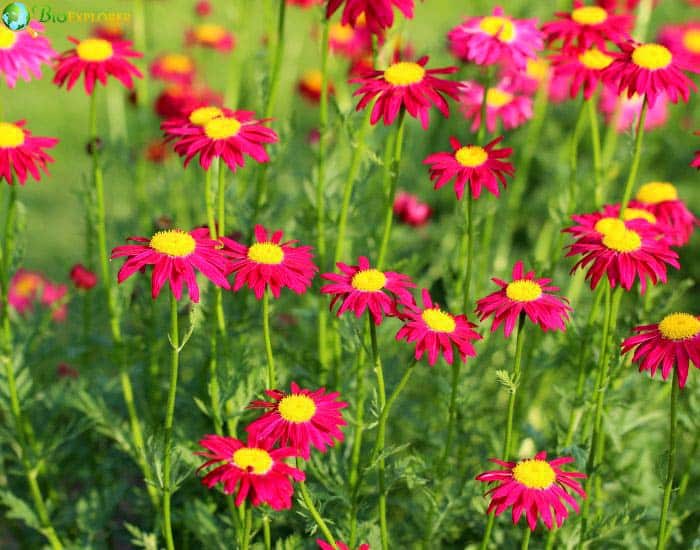
| Plantae | Asterales | Asteraceae | Tanacetum | Tanacetum coccineum |
Painted daisies are like fireworks that decided to grow in your garden. These flowers burst with color, showing off their two-tone petals in a way that’s sure to catch your eye.
Common Names: Painted daisies go by a few other names too. You might hear them called “pyrethrum daisies” or “Persian chrysanthemums”. Some folks even call them “painted ladies” because of their colorful, showy appearance.
Natural Habitat: These pretty flowers originally come from the Caucasus Mountains, stretching between the Black and Caspian Seas. They like to grow in meadows and on grassy slopes in the wild. They’re used to cool mountain air and well-drained soil.
Colors: Painted daisies come in some really bold color combos. You might see red petals with yellow centers, pink petals with dark middles, or even white petals with bright yellow centers. Each flower looks like it’s been hand-painted!
Shape: The petals of painted daisies are long and skinny, kind of like the rays of a firework explosion. And just like fireworks, they really stand out in a crowd.
Growing Tips:
- Plant them where they’ll get lots of sun.
- They like soil that’s rich and drains well.
- Water them regularly, but don’t let them get too soggy.
 Painted daisies aren’t just pretty but useful too! Some gardeners plant them to keep pests away from other flowers.
Painted daisies aren’t just pretty but useful too! Some gardeners plant them to keep pests away from other flowers.5. Gazania: The Treasure Flowers of the Plant World
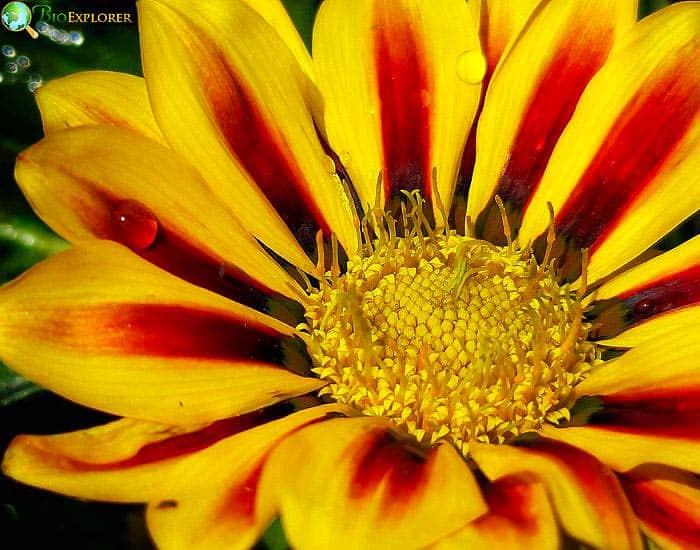
| Plantae | Asterales | Asteraceae | Gazania | Gazania rigens |
Gazanias are like little treasure chests that open up in your garden. These flowers are so bright and cheerful they’re sure to make you smile every time you see them.
Common Names: Gazanias have some fun nicknames. People often call them “treasure flowers” because they look special. You might also hear them called “coastal gazania” or “trailing gazania” because of how they grow.
Natural Habitat: Gazanias come from South Africa[2], just like their cousins, the African daisies. In the wild, you’ll find them growing near the coast and in dry, grassy areas. They’re tough cookies that can handle salty air and sandy soil.
Colors: Gazanias are bicolor superstars. You might see orange petals with dark stripes, yellow flowers with red centers, or even pink blooms with white tips. Each flower looks like it’s wearing its own unique, colorful outfit!
Sun Lovers: Just like African daisies, gazanias are big fans of the sun. They open up wide when it’s sunny and close up at night or when it’s cloudy. It’s like they’re giving the sun a big hug!
Growing Tips:
- Plant them in a spot that gets full sun.
- They don’t need much water they’re tough cookies!
- They’re great for dry, hot areas in your garden.
- Gazanias are perennials in warm climates (USDA zones 9-11).

- Gazanias are sometimes called “treasure flowers”. Maybe it’s because finding one in your garden feels like discovering buried treasure!
- These bicolor flowers attact butterflies.
6. Butterfly Weed: Monarch’s Favorite Pit Stop
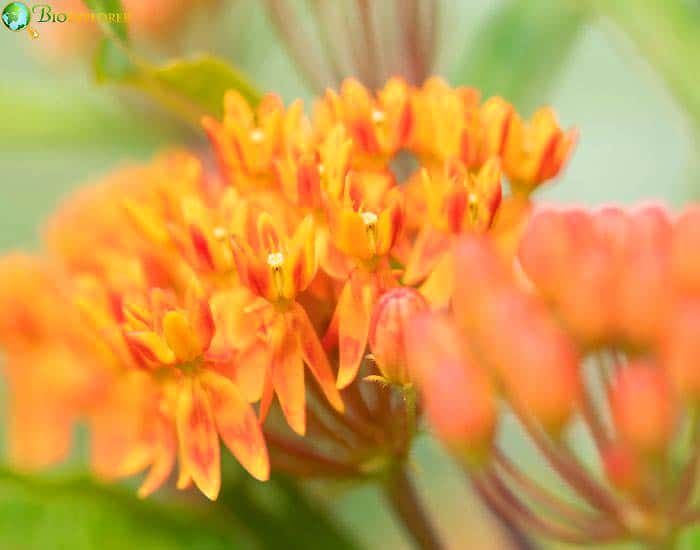
| Plantae | Gentianales | Apocynaceae | Asclepias | Asclepias tuberosa |
Butterfly weed is like a colorful gas station for butterflies, especially monarchs. This flower is a real treat for both bugs and humans!
Common Names: Butterfly weed has several other names that describe its looks or what it does. You might hear it called “orange milkweed”, “pleurisy root” or “Indian paintbrush” (though that’s a different flower too!). Some folks call it “chiggerflower”, but don’t worry – it doesn’t actually attract chiggers. Other alternate names include fluxroot, Indian posy, Orange milkweed, Canada root or yellow milkweed.
Natural Habitat: This pretty plant is native to North America. You’ll find it growing in the wild in prairies, open woods, and along roadsides. It likes dry, sunny spots and can handle poor soil. Butterfly weed is a tough cookie that can grow just about anywhere in the continental United States!
Colors: Butterfly weed usually shows off a bright orange color, but some types also have yellow or red flowers. The centers are often a different shade, giving them that cool two-tone look we love.
Shape: The flowers grow in clusters that look like flat umbrellas. Each tiny flower in the cluster is star-shaped. It’s like a bunch of tiny stars decided to throw a party on your plant!
Growing Tips:
- Plant them in a sunny spot.
- They like soil that drains well no soggy feet for these plants!
- Once they’re settled, they don’t need much water.
 Butterfly weed isn’t a weed at all despite its name. It’s a native wildflower that’s super important for monarch butterflies. The caterpillars eat the leaves, and the adult butterflies drink the nectar.
Butterfly weed isn’t a weed at all despite its name. It’s a native wildflower that’s super important for monarch butterflies. The caterpillars eat the leaves, and the adult butterflies drink the nectar.7. Beach Morning Glory: Sand Dune Decorator

| Plantae | Solanales | Convolvulaceae | Ipomoea | Ipomoea pes-caprae |
Beach morning glory is like nature’s way of adding a splash of color to the beach. These tough little flowers brighten up sandy spots with their pretty two-tone blooms.
Common Names: Beach Morning Glory has several names hinting at where it grows. You might hear it called “railroad vine” because it spreads along the ground like train tracks. Some folks call it “goat’s foot” because of the shape of its leaves. It’s also known as “bayhops” or “beach potato vine”.
Natural Habitat: As its name suggests, Beach Morning Glory loves the coast. It grows on beaches, sand dunes, and coastal areas worldwide in tropical and subtropical regions. It’s a tough plant that can handle salty air, sandy soil, and even being covered by sand!
Colors: These flowers usually show off pink or purple petals with a white or yellow center. It’s like they’re wearing a colorful shirt with a light-colored collar!
Shape: The flowers look like little trumpets or megaphones. Imagine tiny musical instruments growing right out of the sand!
Growing Tips:
- They love full sun the more, the better!
- Plant them in sandy soil that drains well.
- They don’t need much water once they’re settled.

- Beach morning glories are super tough. Their roots can grow really long to find water, sometimes up to 10 feet deep! That’s like having underground straws that are taller than a grown-up.
- This flowering plant’s leaves are shaped like a goat’s footprint, which is the origin of its species name, “pes-caprae”.
8. Coneflower: Purple-Crowned Prairie Royalty
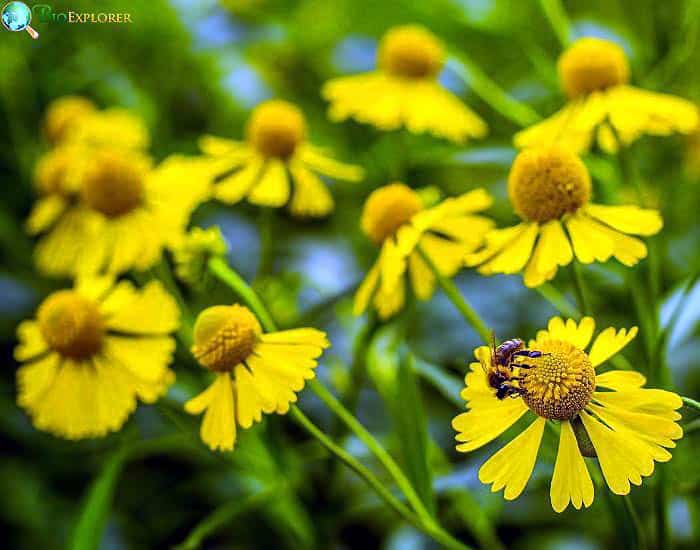
| Plantae | Asterales | Asteraceae | Echinacea | Echinacea paradoxa |
Coneflowers are like the kings and queens of the prairie, with their tall stems and crown-like centers. These tough, pretty flowers are a favorite in many gardens.
Common Names: Most people know them as coneflowers, but they’re also called “hedgehog coneflower” because of their spiky centers. Some call them “yellow coneflower” or “Bush’s purple coneflower”. The name “Echinacea” comes from the Greek word for hedgehog!
Natural Habitat: Echinacea paradoxa, or yellow coneflower, is native to the central United States. You’ll find them growing in the wild in prairies, rocky open woods, and along roadsides. They love sunny spots and can handle dry conditions like in their prairie homes.
Colors: While the most common coneflowers are purple with orange-brown centers, Echinacea paradoxa is special because it’s yellow. The petals are bright yellow, and the center cone is usually brown or dark yellow. It’s like they’re wearing sunny yellow hats with brown tops!
Shape: Coneflowers have a unique look. The petals droop down around a raised center that looks like a spiky cone. It’s as if they’re always doing a cheerleading routine, shouting, “Give me a C!”
Growing Tips:
- Plant them where they’ll get lots of sun.
- They like soil that drains well.
- Once they’re settled, they don’t need much water.
 Native Americans used coneflowers as medicine for all sorts of things, from colds to snake bites. Today, some people still use them to help boost their immune system.
Native Americans used coneflowers as medicine for all sorts of things, from colds to snake bites. Today, some people still use them to help boost their immune system.9. Indian Paintbrush: Nature’s Own Paintbrush
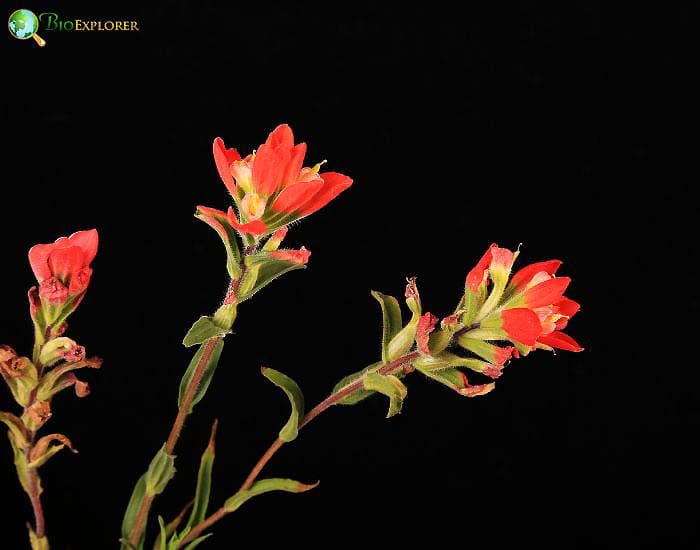
| Plantae | Lamiales | Orobanchaceae | Castilleja | Castilleja indivisa |
Indian Paintbrush is like a little flame growing in the wild. These flowers look like someone dipped them in bright paint, making them stand out wherever they grow.
Common Names: Indian Paintbrush has a few other colorful names. Some call it “prairie-fire” because it lights up fields with color. It’s also known as “painted cup” or “Texas paintbrush”. In some places, folks call it “grandmother’s hair” because of its wispy look.
Natural Habitat: Castilleja indivisa, or Texas Paintbrush, is native to the southern United States, especially Texas and Oklahoma. You’ll find them in the wild in prairies, meadows, and open woods. They love sunny spots and can grow in different soil types, from sandy to clay.
Colors: Most Indian Paintbrushes are bright red or orange-red, but some can be pink, yellow, or even purple. The colorful part isn’t actually the flower – it’s made up of leaves called bracts. The tiny flowers are usually a different color, hiding inside like shy little artists.
Shape: The plant looks like a bunch of paintbrushes sticking up from the ground. Each “brush” is topped with colorful bracts that look like they’ve been dipped in paint[3].
Growing Tips:
- They like full sun or a bit of shade.
- Indian Paintbrushes need special soil and a helper plant to grow well.
- Don’t try to move them they don’t like being transplanted.
 Indian Paintbrushes are partly parasitic (i. e., hemiparasitic). That means they attach their roots to other plants nearby especially grasses, to get some of their nutrients. It’s like they’re borrowing a snack from their plant neighbors!
Indian Paintbrushes are partly parasitic (i. e., hemiparasitic). That means they attach their roots to other plants nearby especially grasses, to get some of their nutrients. It’s like they’re borrowing a snack from their plant neighbors!10. Trillium: Three-Petaled Forest Gems
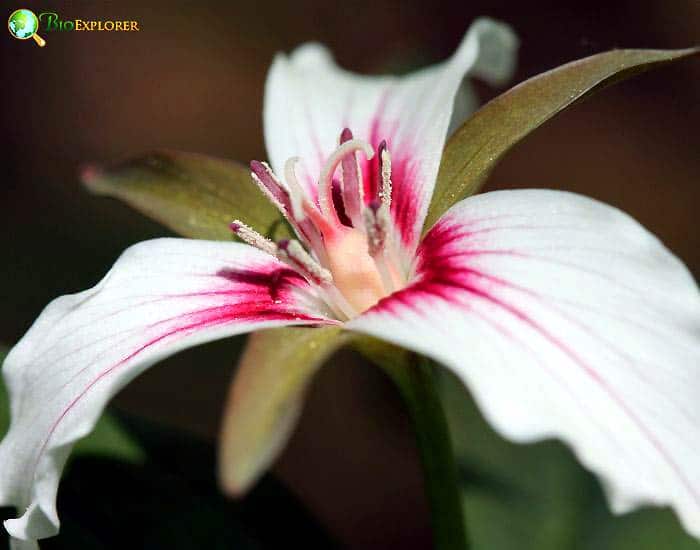
| Plantae | Liliales | Melanthiaceae | Trillium | Trillium undulatum |
Trilliums are like hidden treasures in the forest. These pretty wildflowers pop up in the spring, showing off their unique three-petaled blooms.
Common Names: Trillium undulatum has some fun nicknames[4]. People often call it “Painted Trillium” because of its colorful petals. You might also hear it called “Smiling Wake Robin” or “Mountain Wood Lily”. Some folks even call it “Wild Pepper” because of the shape of its fruit!
Natural Habitat: Painted Trillium loves cool, damp forests. In the wild, you’ll find it growing in the Appalachian Mountains, from Georgia all the way up to Canada. It likes to hide under the shade of big trees, often near streams or in rocky areas.
Colors: Painted Trillium is a true bicolor beauty. It has white petals with a splash of pink or red at the base, making a V-shape. It’s like each flower is wearing a fancy white dress with a colorful sash!
Shape: Trilliums are all about the number three. They have three petals, three sepals (the green parts under the petals), and three leaves. It’s like they’re playing a game of “three of everything”!
Growing Tips:
- Plant them in a shady spot they love living under trees.
- They like rich, moist soil that drains well.
- Be patient they grow slowly and can take years to flower.
- These bicolors bloom from late April to the end of June.

- Ants help spread trillium seeds. The seeds have a tasty coating that ants love to eat. After they munch on the coating, they leave the seed behind, helping new trilliums grow. It’s like the ants are tiny gardeners!
- Trillium is the hosting plant for certain moth species such as Black-patched clepsis moth and American angle shades moth[5].
11. Lewisia: Rock Garden Jewels
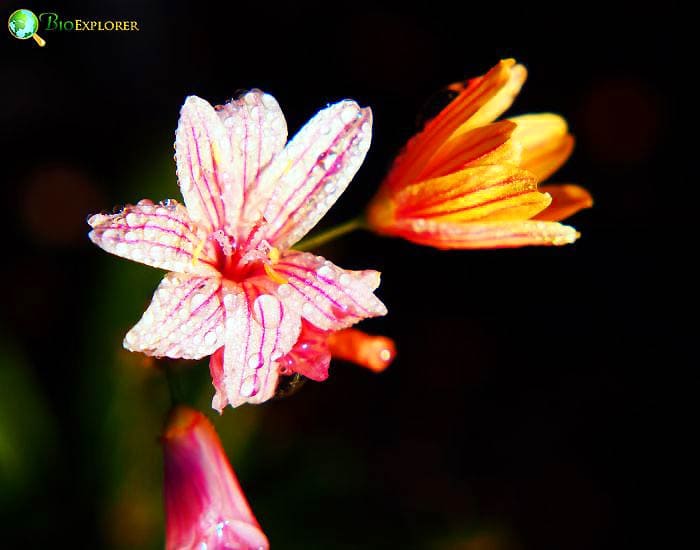
| Plantae | Caryophyllales | Montiaceae | Lewisia | Lewisia cotyledon |
Lewisia flowers are like living gemstones that grow in rocky places. These tough little plants show off bright, colorful blooms that can light up even the driest gardens.
Common Names: Lewisia cotyledon is often called “Cliff Maids” because they like to grow on rocky cliffs. Some people call them “Siskiyou Lewisia” after the mountains where they’re found. You might also hear them called “Cotyledon Lewisia” or simply “Bitterroot”. However, that name usually refers to a different Lewisia species.
Natural Habitat: These pretty flowers come from northern California and southern Oregon mountains. You’ll find them growing on rocky cliffs, crevices, and steep, gravelly slopes in the wild. They’re tough plants that can handle harsh mountain weather and poor soil[6].
Colors: Lewisias are bicolor beauties. Their flowers often have petals, one color on the outside and another on the inside. You might see pink petals with orange stripes, white flowers with red lines, or even yellow blooms with purple edges. It’s like each flower is wearing a fancy reversible jacket!
Shape: Lewisia flowers grow in clusters on top of short stems. Each flower looks like a tiny water lily or a star with lots of petals. The leaves grow in a tight rosette at the base, like a little green cushion.
Growing Tips:
- Plant them in a spot that gets sun but some afternoon shade.
- They need very well-draining soil think rocky or gravelly.
- Don’t water them too much they’re used to dry conditions.
 Lewisias are named after Meriwether Lewis of the Lewis and Clark expedition. He collected samples of a different Lewisia species during their famous journey across America.
Lewisias are named after Meriwether Lewis of the Lewis and Clark expedition. He collected samples of a different Lewisia species during their famous journey across America.12. Lenten Rose: Winter’s End Heralded in Two-Tone
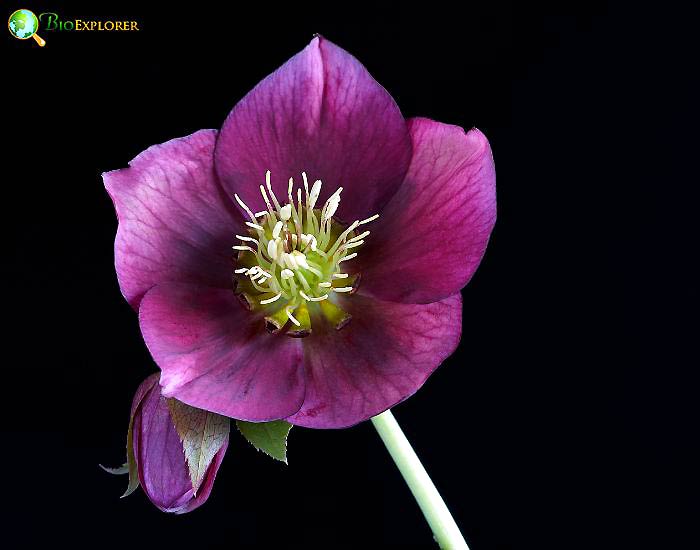
| Plantae | Ranunculales | Ranunculaceae | Helleborus | Helleborus orientalis |
Lenten Roses are like brave garden heroes, blooming when most other flowers are still sleeping. These tough plants bring color to gardens in late winter and early spring.
Common Names: Despite its name, the Lenten Rose isn’t a rose at all! It’s also called “Oriental Hellebore” or “Christmas Rose” (even though it usually blooms later). Some folks call it “Winter Rose” because it flowers when it’s still chilly outside[7].
Natural Habitat: Helleborus orientalis comes from the forests of Turkey and Greece. In the wild, you’ll find them growing in shady, woody areas with rich soil. They’re used to cool temperatures and don’t mind a bit of snow!
Colors: Lenten Roses are bicolor champions. You might see white flowers with pink spots, green petals with purple edges, or even dark purple blooms with lighter centers. Many Lenten Roses change color as they age, like they’re playing dress-up!
Shape: The flowers look like big, open cups or bowls. They nod downward as if they’re too shy to look up. The leaves are dark green and leathery, staying green all year round.
Growing Tips:
- Plant them in a shady spot they don’t like too much sun.
- They like rich soil that doesn’t dry out.
- Once they’re happy, they’ll come back year after year.

- In the old days, people thought Hellebores had magical powers. They believed these flowers could drive away evil spirits and cure madness!
- Hellebores contain alkaloids that can cause mild dermatitis in sensitive individuals and make the plants unpalatable to deer and rabbits.
13. Clarkia: Farewell-to-Spring in Technicolor
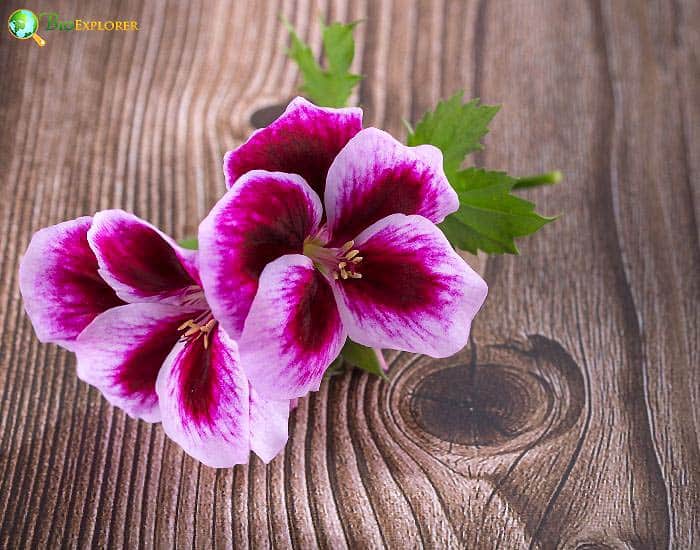
| Plantae | Myrtales | Onagraceae | Clarkia | Clarkia amoena |
Clarkia flowers are like nature’s fireworks, bursting with color just as spring says goodbye. These cheerful blooms bring a final splash of brightness before summer sets in.
Common Names: Clarkia amoena goes by several pretty names. It’s often called “Farewell-to-Spring” because it blooms late in the season. You might also hear it called “Godetia” or “Satin Flower” because of its silky petals. Some folks call it “Herald of Summer” since it blooms right before summer starts.
Natural Habitat: These colorful flowers are native to western North America. In the wild, you’ll find them growing in open, sunny meadows, on coastal bluffs, and in light woodlands. They love areas that get lots of sun and have well-drained soil.
Colors: Clarkias are bicolor beauties. You might see pink petals with white centers, lavender flowers with darker purple spots, or salmon-colored blooms with red streaks. It’s like each flower is wearing a tie-dye t-shirt!
Shape: Clarkia flowers look like little cups or goblets. They grow in clusters along tall stems, creating a display that looks like a colorful tower. The petals often have a crinkled or ruffled edge, adding to their charm.
Growing Tips:
- Plant them in a sunny spot they love basking in the light[8].
- They like soil that drains well.
- Sow the seeds directly in the garden in early spring.
 Clarkias are named after William Clark of the Lewis and Clark expedition. These explorers discovered many new plants on their famous journey across America.
Clarkias are named after William Clark of the Lewis and Clark expedition. These explorers discovered many new plants on their famous journey across America.14. Bird of Paradise: Tropical Splendor in Flower Form
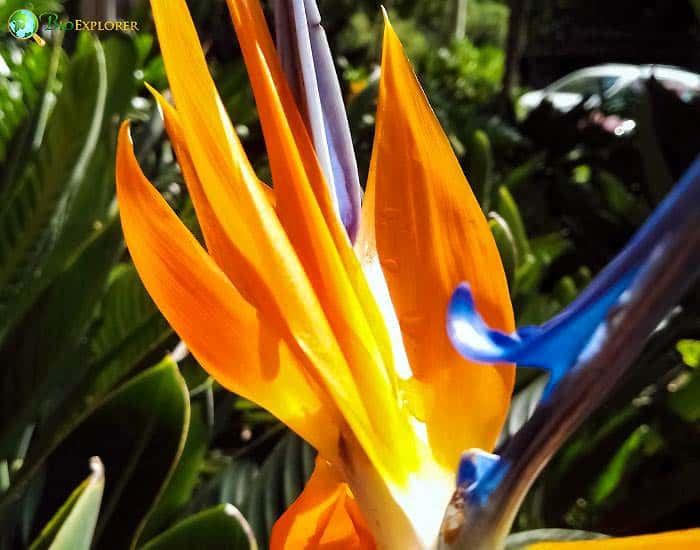
| Plantae | Zingiberales | Strelitziaceae | Strelitzia | Strelitzia reginae |
Bird of Paradise flowers are like living sculptures, bringing a touch of the tropics to any garden. These stunning blooms look just like colorful birds taking flight!
Common Names: The Bird of Paradise flower has some other fancy names. People sometimes call it “Crane Flower” because it looks like a bird’s head. In Hawaii, it’s known as “Little Globe” and some folks call it “Strelitzia” after its scientific name.
Natural Habitat: These eye-catching flowers come from South Africa. You’ll find them growing in the wild in coastal areas and along riverbanks. They love warm, sunny spots and can handle salty air, which makes them perfect for coastal gardens.
Colors: Bird of Paradise flowers are true bicolor beauties. The “bird” part of the flower is usually bright orange or yellow, while the “beak” is a deep blue or purple. It’s like they’re wearing a colorful costume for a tropical party!
Shape: The flower looks like a bird’s head peeking out from green leaves. The orange or yellow parts are modified leaves, while the blue “beak” holds the real flowers. It’s nature’s way of playing dress-up!
Growing Tips:
- They need lots of sun the more, the better.
- Plant them in rich, well-draining soil.
- They like it warm, so protect them from cold winds.

- The Bird of Paradise is the official flower of Los Angeles. It’s like these flowers are Hollywood stars!
- Bird of Paradise plants can grow up to 12 feet tall.
15. Passion Flower: Nature’s Clock in Bloom
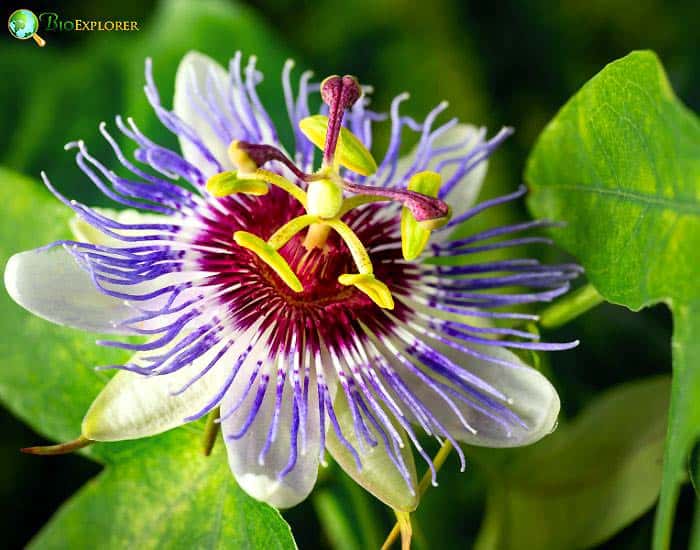
| Plantae | Malpighiales | Passifloraceae | Passiflora | Passiflora caerulea |
Passion Flowers are like nature’s own kaleidoscopes, with intricate patterns and colors that seem almost too fancy to be real. These stunning blooms are sure to be the talk of any garden!
Common Names: Passiflora caerulea has some interesting nicknames. It’s often called “Blue Passion Flower” because of its color. Some people call it “Clock Flower” because its parts look like clock hands. In some places, it’s known as “Blue Crown” or “Mary’s Star” because of its shape.
Natural Habitat: This particular passion flower comes from South America, mainly Brazil, Paraguay, and Argentina. In the wild, you’ll find them climbing up trees and over bushes in forests and along riversides. They love warm, humid places and can grow pretty quickly!
Colors: Passion Flowers are bicolor wonders. The main part of the flower is usually white or pale blue, with a frilly crown that’s purple or blue. In the center, you’ll see green and yellow parts too. It’s like they couldn’t decide on just one or two colors, so they chose them all!
Shape: These flowers look super complicated, like a fancy piece of jewelry. They have a ring of petals, then a frilly crown, and in the middle, some parts stick up like little pillars. It’s as if the flower is wearing a fancy hat with lots of decorations!
Growing Tips:
- Give them something to climb on, like a trellis or fence.
- They like full sun or partial shade.
- Water them regularly, especially when they’re growing.

- The name “Passion Flower” doesn’t mean what you might think! It comes from Christian missionaries who thought the flower parts symbolized parts of the Passion of Christ.
- Passiflora caerulea can take a year or more to establish before flowering profusely[9].
16. Showy Lady’s Slipper: Orchid Royalty of the North
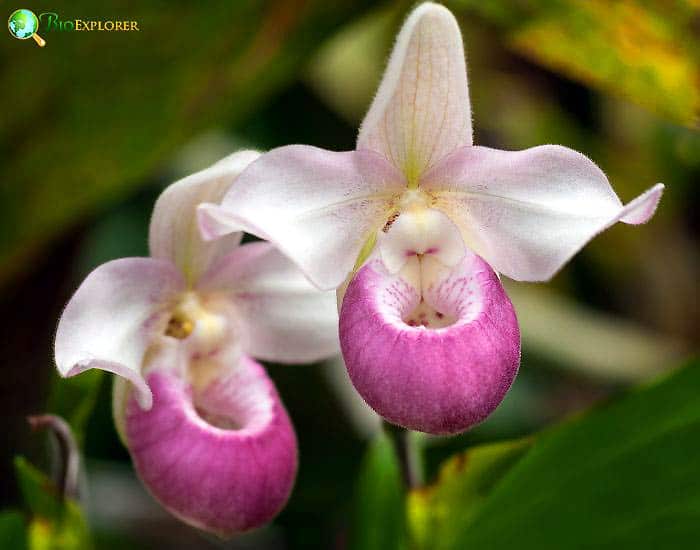
| Plantae | Asparagales | Orchidaceae | Cypripedium | Cypripedium reginae |
Showy Lady’s Slippers are like the princesses of the wildflower world. These stunning orchids are rare beauties that bring a touch of magic to woodlands and gardens.
Common Names: This flower has some fancy names to match its looks. It’s often called the “Pink-and-white Lady’s-slipper” because of its colors. Some folks call it “Queen’s Lady’s-slipper” or “Royal Lady’s-slipper” – fit for a queen! In some places, it’s known as the “Showy Orchid” or “Silver-slipper. “
Natural Habitat: Showy Lady’s Slippers are native to North America. In the wild, you’ll find them in swampy areas, wet meadows, and damp forests. They love cool, moist places and often grow near cedar trees. These colorful orchids are most common in the northeastern United States and southeastern Canada.
Colors: These orchids are true bicolor beauties. The “slipper” part is usually a bright pink or magenta, while the rest of the flower is white. Sometimes, the white parts have a bit of pink blush too. It’s like the flower is wearing fancy pink shoes with a white dress!
Shape: The flower looks like a slipper or pouch, with petals and sepals spreading above it like a fancy hat. It’s as if the flower is all dressed up for a royal ball!
Growing Tips:
- They need partial shade too much sun can hurt them.
- Plant them in soil that’s always a bit damp but not soggy.
- Be patient they grow slowly and may take over 16 years to flower[10].

- Showy Lady’s Slippers are the state flower of Minnesota since 1902. They’re protected in many areas of Minnesota because they’re becoming rare in the wild.
- The plant can cause dermatitis due to an irritant called cypripedin.
- It can live up to 50 years and form large clumps in favorable conditions.
17. Lotus: Sacred Beauty Rising from the Mud
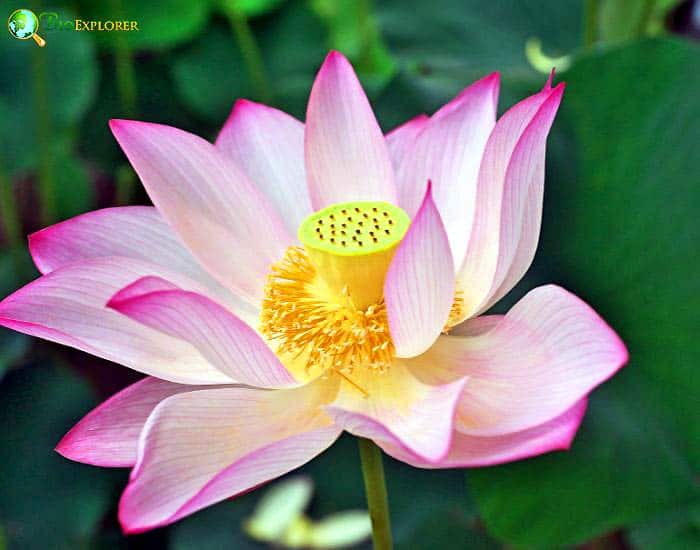
| Plantae | Proteales | Nelumbonaceae | Nelumbo | Nelumbo nucifera |
Lotus flowers are like nature’s own magic trick. They start life in murky water but grow into stunning blooms that seem to float above it all.
Common Names: The lotus goes by many names. It’s often called “Sacred Lotus” because it’s important in many religions. Some people call it “Indian Lotus” or “Bean of India”. In China, it’s known as “Lian”. You might also hear it called “Water Lily”, but that’s actually a different plant!
Natural Habitat: Lotus plants are native to Asia and northern Australia. In the wild, they grow in shallow ponds, lakes, and slow-moving rivers. They love warm, wet places and can handle water that’s a bit muddy.
Colors: Lotus flowers are often bicolor beauties. The most common colors are pink and white, with the outer petals being darker pink and the inner ones lighter or white. But you can also find all white, pink, or even yellow lotuses!
Shape: Lotus flowers are big and showy. They have lots of petals that open up wide, like a water ballet dancer doing a twirl. The center of the flower looks like a shower head, full of yellow stamens. The leaves are huge and round, often sitting right on top of the water like little green lily pads.
Growing Tips:
- They need lots of sun and warm water to grow well.
- Plant them in big pots filled with mud, then submerge the pots in water.
- Be patient it can take a while for new plants to bloom.
 Lotus seeds can stay alive for a really long time. Scientists once grew a lotus plant from a 1,300-year-old seed! That’s older than some countries!
Lotus seeds can stay alive for a really long time. Scientists once grew a lotus plant from a 1,300-year-old seed! That’s older than some countries!18. Fringed Gentian: Blue Beauties of the Late Summer
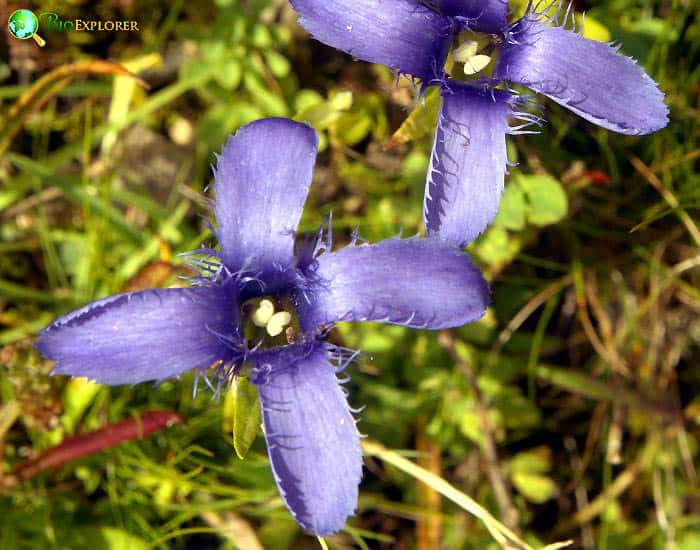
| Plantae | Gentianales | Gentianaceae | Gentianopsis | Gentianopsis crinita |
Fringed Gentians are like little blue stars that pop up when summer is winding down. These delicate flowers bring a burst of color to meadows and gardens just when everything else is starting to fade.
Common Names: People call this flower by different names describing its appearance. “Fringed Gentian” is the most common because of its fringy petals. Some folks call it “Blue Fringe” or “Blue Fringed Gentian”. In some places, it’s known as the “Late Blue Gentian” because it blooms late in the season.
Natural Habitat: These pretty blue flowers are native to North America. You’ll find them in the wild in damp meadows, prairies, and along streams. They love open, sunny spots with moist soil. Fringed Gentians are most common in the northeastern United States and parts of Canada.
Colors: While Fringed Gentians are famous for their bright blue color, they can sometimes show off two tones. The main part of the flower is usually a deep, sky blue. But the fringe on the petals can be a lighter blue or even white, creating a subtle two-tone effect. It’s like each flower is wearing a fancy blue dress with a frilly white collar!
Shape: The flowers look like little trumpets or vases with fringed edges. They open up during the day when it’s sunny and close at night or when it’s cloudy. It’s as if they’re shy and only want to show off when the sun is out!
Growing Tips:
- They need full sun to grow well.
- Plant them in soil that stays moist but drains well.
- Be patient they’re biennial, which means they only flower in their second year.
 Fringed Gentians were a favorite of many poets, including William Cullen Bryant[11] and Emily Dickinson. They wrote poems about how beautiful and rare these flowers are!
Fringed Gentians were a favorite of many poets, including William Cullen Bryant[11] and Emily Dickinson. They wrote poems about how beautiful and rare these flowers are!19. Jack-in-the-Pulpit: The Preacher of the Woods
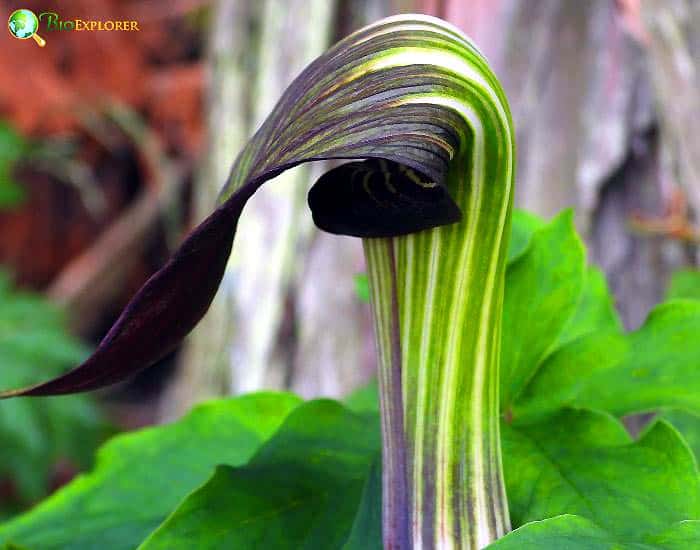
| Plantae | Alismatales | Araceae | Arisaema | Arisaema triphyllum |
Jack-in-the-Pulpit is like nature’s own magic trick. This unique flower looks more like a fancy green and purple striped umbrella than a typical bloom!
Common Names: This plant has lots of fun nicknames. Some people call it “Indian Turnip” because Native Americans used its root for food. You might hear “Bog Onion” or “Brown Dragon” too. Kids sometimes call it “Memory Root” because the root can make your mouth tingly!
Natural Habitat: Jack-in-the-Pulpit is a woodland plant native to eastern North America. You’ll find it growing in the wild in moist, shady forests. It loves rich, damp soil and doesn’t mind if it’s a bit chilly.
Colors: This plant is a subtle bicolor beauty. The “pulpit” part (called a spathe[12]) is usually green with purple or brown stripes. Inside, the “Jack” (actually called a spadix) can be green, purple, or even black. It’s like the plant is wearing a striped coat with a colorful surprise inside!
Shape: Jack-in-the-Pulpit doesn’t look like your typical flower. It has a hood-like part (the pulpit) with a skinny spike (Jack) sticking up inside. Below this are three big leaves. The whole thing looks a bit like a person standing at a fancy podiusm!
Growing Tips:
- Plant them in a shady spot they don’t like too much sun.
- They like soil that’s always a bit damp.
- Be patient they can take a few years to get established.

- After the flowers fade, Jack-in-the-Pulpit plants make bright red berries.
- Birds love to eat these, but people shouldn’t they can make you sick (tingly sensation or irritation if ingested) as they contain calcium oxalate crystals!
20. Turk’s Cap Lily: Nodding Elegance in the Wild
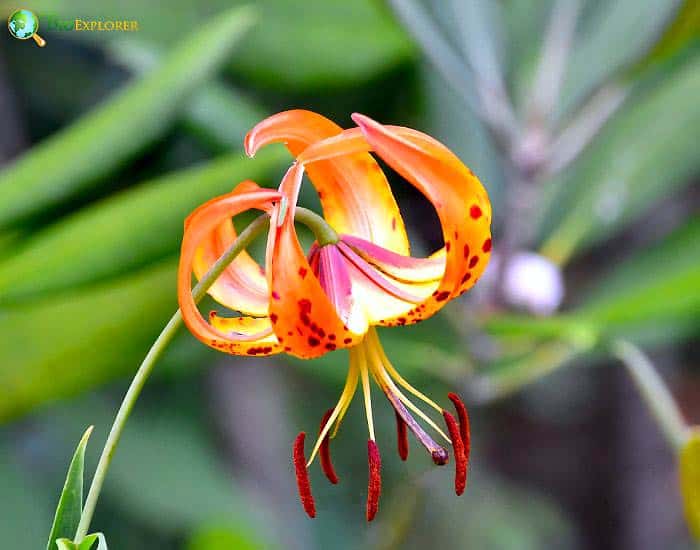
| Plantae | Liliales | Liliaceae | Lilium | Lilium superbum |
Turk’s Cap Lilies are like nature’s own chandeliers, with their big, drooping flowers that light up shady spots in the woods.
Common Names: This flower has some fancy names to match its looks. People often call it “Superb Lily” because it’s superb! You might also hear “American Tiger Lily” or “Swamp Lily”. Some folks call it “Nodding Lily” because of how the flowers hang down.
Natural Habitat: Turk’s Cap Lilies are native to eastern North America[13]. You’ll find them in the wild in moist woods, stream banks, and meadows. They love spots that are a bit damp and shady, but can handle some sun too.
Colors: These lilies are bicolor beauties. The main color is usually a bright orange or reddish-orange. But each petal has dark spots, usually reddish-brown or purple. The center of the flower and the stamens are often a contrasting green. It’s like each flower is wearing a polka-dot dress with green jewelry!
Shape: The flowers look like caps or turbans, which is why they’re called “Turk’s Cap”. The petals curve backwards, showing off the inside of the flower. Each plant can have lots of flowers, all nodding downwards as if they’re too shy to look up.
Growing Tips:
- Plant them where they’ll get morning sun but afternoon shade.
- They like rich, moist soil that drains well.
- Don’t plant them too deep just a couple inches down.

- Turk’s Cap Lilies can grow really tall up to 8 feet! That’s taller than most people. It’s like having a flower skyscraper in your garden!
- A single fully matured Turk’s Cap lily plant can bear up to 40 individual flowers.
- These bicolor varieties pollinate with the help of butterflies and hummingbirds.
21. Coral Root Orchid: The Ghostly Forest Dweller
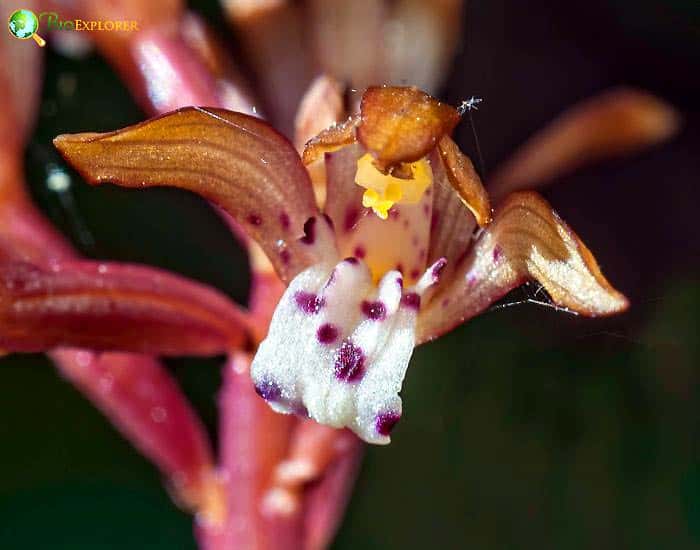
| Plantae | Asparagales | Orchidaceae | Corallorhiza | Corallorhiza maculata |
Coral Root Orchids are like little forest ghosts, popping up in shady spots without any green leaves. These unusual orchids are a rare and exciting find for any nature lover!
Common Names: This orchid has some spooky-sounding names. It’s often called “Spotted Coral Root” because of its spotted flowers. Some people call it “Summer Coral Root” since it blooms in summer. You might also hear “Dragon’s Claws” or “Crawley Root” because of how its roots look.
Natural Habitat: Coral Root Orchids are found in North America, from Alaska to Florida. In the wild, you’ll find them in shady, damp forests. They love cool, dark places and often grow near pine or oak trees. These orchids are different because they don’t have any green leaves – they get their food from dead plant material in the soil!
Colors: These orchids are subtle bicolor beauties. The main stem is usually reddish-brown or purplish. The tiny flowers are white or pale pink with purple spots[14] or lines. It’s like they’re wearing little polka-dot dresses!
Shape: Coral Root Orchids don’t look like typical flowers. They have a thin stem with small, delicate flowers clustered near the top. The flowers look a bit like tiny ghosts or fairies dancing on the stem. The plant gets its name from its roots, which look like pieces of coral.
Growing Tips:
- These orchids are hard to grow in gardens best enjoyed in the wild.
- If you find them, look but don’t touch they’re delicate and often protected.
- Remember where you saw them and come back next year they often return to the same spot.
 Coral Root Orchids are mycoheterotrophs – that means they get their food from fungi in the soil instead of making it themselves through photosynthesis. It’s like they’re little forest recyclers!
Coral Root Orchids are mycoheterotrophs – that means they get their food from fungi in the soil instead of making it themselves through photosynthesis. It’s like they’re little forest recyclers!22. Blue-eyed Mary: Seaside Stunner
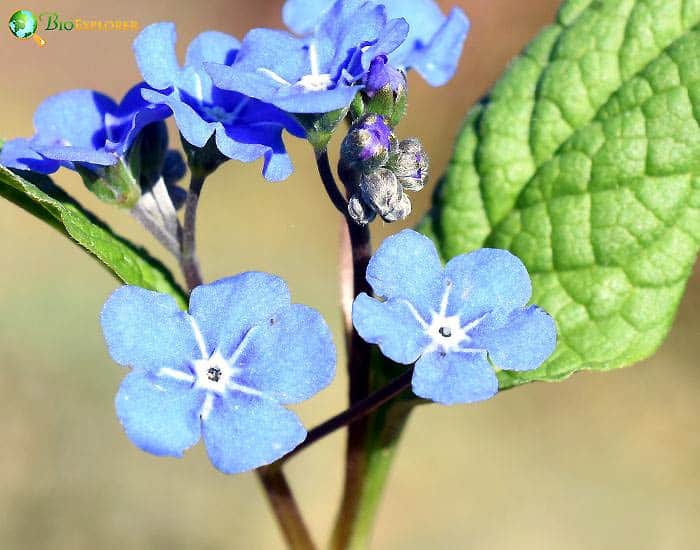
| Plantae | Lamiales | Plantaginaceae | Collinsia | Collinsia grandiflora |
Blue-eyed Mary flowers are like tiny faces peeking out from the grass, with their bright blue and white blooms that seem to be smiling at you!
Common Names: This cheerful flower has a few sweet nicknames. Some folks call it “Large-flowered Blue-eyed Mary” because of its bigger blooms. You might hear “Chinese Houses” too, since the flower clusters look a bit like pagodas. It’s known as “Innocence” in some places because of its pure, simple beauty.
Natural Habitat: Blue-eyed Mary is native to western North America (from British Columbia to California and east to Idaho and Utah). You’ll find them in the wild in open woodlands, grassy slopes, and coastal areas[15]. They love spots that get some sun but aren’t too hot or dry. These pretty flowers are often found carpeting forest floors in spring.
Colors: True to their name, Blue-eyed Marys are bicolor beauties. The upper part of the flower is usually a bright blue or purple, while the lower lip is white. It really does look like a blue-eyed face smiling up at you! Some varieties might have pink or lavender instead of blue.
Shape: The flowers are small but showy, growing in clusters up the stem. Each little bloom looks like it has two lips, with the top one folded back a bit. When a whole bunch of them bloom together, it’s like a little crowd of friendly faces!
Growing Tips:
- They like partial shade too much sun can make them wilt.
- Plant them in soil that drains well but stays a bit moist.
- Scatter seeds in fall for spring blooms they’re great self-seeders!
- The bloom time is from April to June.

- Blue-eyed Marys are annual plants, which means they complete their whole life cycle in one year. But don’t worry they often drop seeds that grow into new plants next year!
- This bicolor flowering plant is drought tolerant and deer resistant.
- This flower attracts native bees, butterflies, bumblebees, and hover flies.
23. Shooting Star: Cosmic Beauty in Miniature
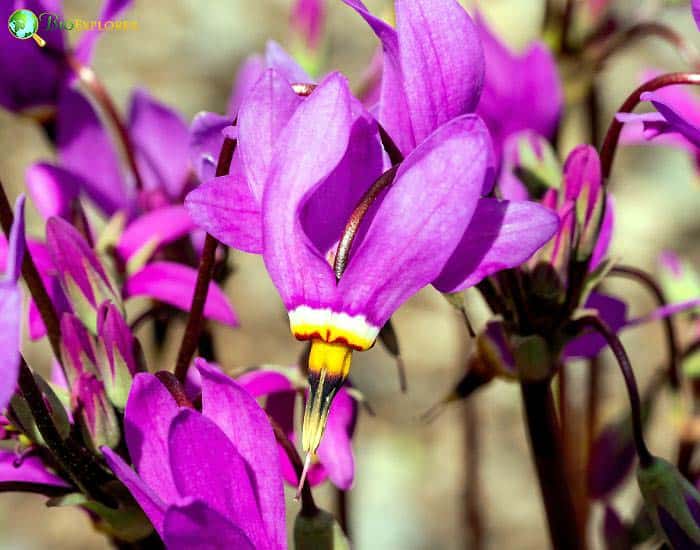
| Plantae | Ericales | Primulaceae | Dodecatheon | Dodecatheon meadia |
Shooting Star flowers are like little comets zooming through your garden. These unique blooms look just like their name suggests – stars falling from the sky!
Common Names: This flower has some fun space-themed names. Besides “Shooting Star”, people often call it “Prairie Pointers” or “American Cowslip”. Some folks say “Pride of Ohio” because it’s common there. You might even hear “Roosterheads” because of how the flowers nod.
Natural Habitat: Shooting Stars are native to North America. You’ll spot them in the wild in open woods, prairies, and rocky slopes. They love spots that are sunny in spring but get shadier as trees leaf out. These pretty flowers often grow in big groups, creating a starry show on the forest floor.
Colors: Shooting Stars are subtle bicolor beauties. The petals are usually pale pink, lavender, or white, while the center of the flower (where the petals meet) is often yellow or dark purple. It’s like each flower has a bright core with colorful tails streaming behind!
Shape: True to their name, these flowers really do look like shooting stars. The petals sweep backwards, forming the “tail” of the star, while the pointed center sticks out in front like the head of a comet. When they’re in full bloom, a patch of Shooting Stars looks like a meteor shower frozen in time!
Growing Tips:
- Plant them where they’ll get spring sun but summer shade.
- They like soil that’s moist in spring but can dry out in summer.
- Be patient they often go dormant in summer and pop back up next spring.
 The stems slowly bend towards the ground after the flowers bloom. This helps the seeds scatter close to the parent plant. It’s like the plant is planting its own garden!
The stems slowly bend towards the ground after the flowers bloom. This helps the seeds scatter close to the parent plant. It’s like the plant is planting its own garden!24. Toad Lily: Spots and Speckles in the Shade
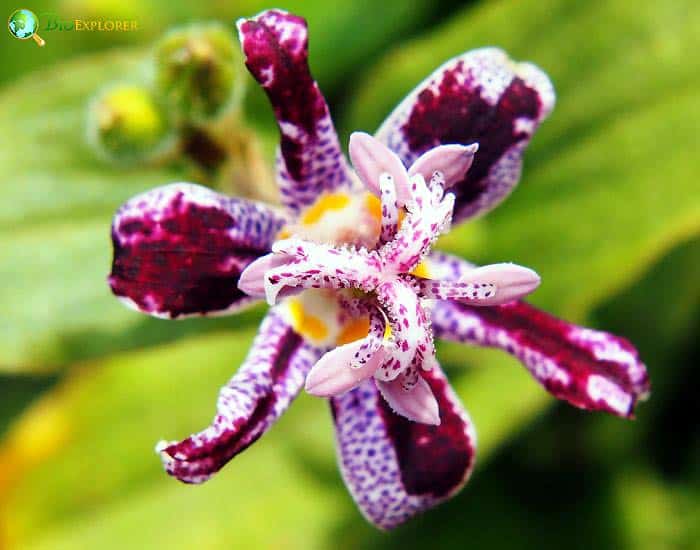
| Plantae | Liliales | Liliaceae | Tricyrtis | Tricyrtis hirta |
Toad Lilies are like nature’s own polka-dot party in the garden. These quirky flowers bring fun to shady spots with their uniquely speckled blooms!
Common Names: Despite its name, the Toad Lily isn’t related to toads or true lilies! Some people call it “Hairy Toad Lily” because of the tiny hairs on its stems. You might hear “Spotted Toad Lily” or “Japanese Toad Lily” too. In Japan, it’s known as “Hototogisu”, named after a bird with similar spots.
Natural Habitat: Toad Lilies come from East Asia, mainly Japan[16] and Korea. You’ll find them growing in the wild in moist, shady mountain forests. They love cool, damp places and often grow near streams or in rocky areas.
Colors: Toad Lilies are bicolor beauties with a twist. The base color is usually white or pale purple, but they’re covered in dark purple or reddish spots. Some varieties have a yellow throat too. It’s like each flower put on its fanciest polka-dot outfit!
Shape: These flowers look a bit like orchids. Their six pointed petals open wide, showing off their speckled insides. The flowers grow along arching stems, often peeking out from under the leaves. It’s as if they’re playing hide-and-seek in your garden!
Growing Tips:
- Plant them in a shady spot they don’t like too much sun.
- They love rich, moist soil think woodland floor.
- Give them plenty of space they can spread over time.
- These flowers are hardy in USDA zones 4-8.
 Toad Lilies bloom in late summer and fall when most other flowers are done. It’s like they’re throwing one last garden party before winter!
Toad Lilies bloom in late summer and fall when most other flowers are done. It’s like they’re throwing one last garden party before winter!25. Prairie Fire: Nature’s Own Paintbrush
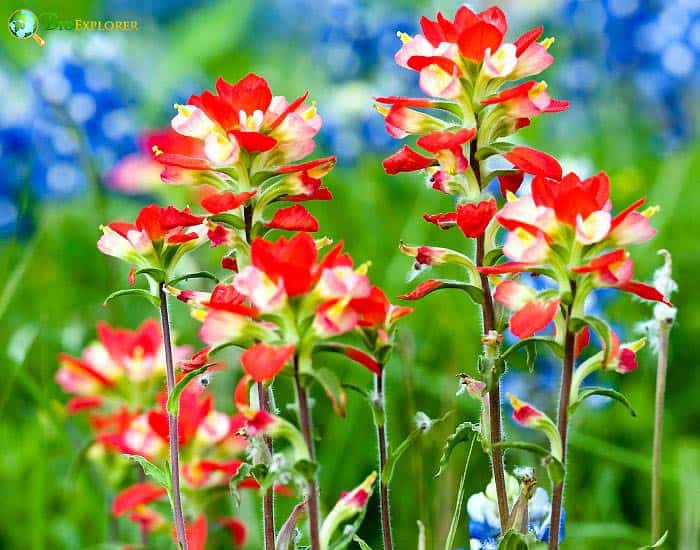
| Plantae | Lamiales | Orobanchaceae | Castilleja | Castilleja coccinea |
Indian Paintbrush is like a living flame in the wild, with its bright red “brushes” that look like they’ve been dipped in paint. These flowers add a pop of color to meadows and prairies.
Common Names: This flower has several colorful nicknames. Besides “Indian Paintbrush”, it’s often called “Prairie Fire” because of how it lights up fields with color. Some folks call it “Painted Cup” or “Scarlet Paintbrush”. In some Native American languages, it’s known as “Grandmother’s Hair”.
Natural Habitat: Castilleja coccinea is native to eastern and central North America. You’ll find them in the wild in prairies, meadows[17], and open woodlands. They love sunny spots with well-draining soil. These flowers are often found growing alongside grasses and other wildflowers.
Colors: Indian Paintbrushes are bicolor beauties in an unusual way. The actual flowers are small and green but surrounded by bright red or orange leaf-like bracts. These bracts give the plant its “painted” look. It’s like the plant is wearing a bright red hat over its green clothes!
Shape: The plant looks like a bunch of paintbrushes sticking up from the ground. Each “brush” is topped with the colorful bracts that surround the tiny flowers. The overall effect is like a bouquet of little red torches.
Growing Tips:
- They need full sun to thrive.
- Indian Paintbrushes are partly parasitic they grow best near other plants.
- Don’t try to transplant them they don’t like being moved.
 Different species of Indian paintbrushes can be in different colors. While red is most common, you can find orange, pink, and even white varieties in different parts of North America.
Different species of Indian paintbrushes can be in different colors. While red is most common, you can find orange, pink, and even white varieties in different parts of North America.Growing Your Own Bicolor Garden
Want to bring the magic of two-toned flowers to your own yard? Let’s dive into how you can create a garden bursting with bicolor beauties!
Tips for Cultivating These Dual-Toned Darlings
- Know your zone: Different bicolor flowers thrive in different climates. Check your hardiness zone before picking your plants.
- Sun or shade: Some bicolor flowers love basking in the sun, while others prefer cool shade. Match the right plant to the right spot in your garden.
- Soil matters: Most bicolor flowers like well-draining soil. Mix in some compost to give them a nutrient boost.
- Water wisely: Some flowers, like Gazanias, like it dry. Others, like Trilliums, love moisture. Learn what each plant needs.
- Give them space: Don’t crowd your plants. Give them room to grow and show off their colors.
Creating Color Combos That Pop
Bicolor flowers are already eye-catching, but you can make them stand out even more:
- Contrast is key: Plant solid-colored flowers next to bicolor ones to make the two-toned blooms really pop.
- Go for groups: Plant clusters of the same bicolor flower for a bigger impact.
- Mix and match: Combine different bicolor flowers with complementary colors for a rainbow effect.
Bicolor Flowers for Every Season
You can enjoy two-toned blooms all year round:
- Spring: Start with Trilliums and Columbines.
- Summer: Move on to Coneflowers and Bird of Paradise.
- Fall: Enjoy late bloomers like Toad Lilies.
- Winter: Some Hellebores (Lenten Roses) bloom in late winter.
Fun Fact: Did you know some bicolor flowers change their colors as they age? It’s like having a new flower every few days!
Remember, gardening is all about experimenting and having fun. Don’t be afraid to try new combinations and see what works best in your unique space. Happy planting!
Frequently Asked Questions
Are all bicolor flowers hybrids?
Nope! While some bicolor flowers are created by plant breeders, many occur naturally in the wild. For example, Trilliums and Indian Paintbrushes have been showing off their two-toned looks in nature for thousands of years!
Which bicolor flowers are easiest to grow?
If you’re new to gardening, try these easy-to-grow bicolor beauties:
- Sweet Peas (Lathyrus odoratus).
- Gazanias (Gazania rigens)
- Painted Daisies (Tanacetum coccineum).
These flowers are pretty tough and can handle different growing conditions.
Can I create my own bicolor flowers?
You sure can! Plant breeders do this all the time. But it takes patience and know-how. If you want to try, start with plants that already have different color varieties, like Petunias or Pansies. Then, learn about cross-pollination. It’s like being a flower matchmaker!
Do bicolor flowers change colors as they age?
Some do! Flowers like the Lenten Rose (Helleborus orientalis) and some Orchids can change color as they get older. It’s like they’re playing dress-up in your garden!
Are there any night-blooming bicolor flowers?
Yes! While not as common, some night-blooming flowers can be bicolored. The night-blooming cereus (Epiphyllum oxypetalum) sometimes has white petals with a yellow center. Moon flowers (Ipomoea alba) can have a slight green tint in their centers, creating a subtle two-tone effect.
How do I care for bicolor flowers in a bouquet?
To keep bicolor flowers looking fresh in a vase:
- Cut stems at an angle before putting them in water.
- Change the water every couple of days.
- Keep the bouquet away from direct sunlight and heat.
- Remove any leaves that fall below the waterline.
Remember, each type of flower might need slightly different care, so ask your florist for specific tips!
Final Thoughts
Bicolor flowers show us that nature loves to play with colors, too. They remind us to look closely at the world around us – you never know what surprising beauty you might find!
Whether you’re a seasoned gardener or just someone who likes pretty things, we hope this tour of bicolor blooms has inspired you. Maybe you’ll plant some in your garden or just stop to admire the next two-toned flower you see.
Either way, next time you spot a flower that looks like it can’t make up its mind what color to be, you’ll know – you’ve just met one of nature’s bicolor beauties!



